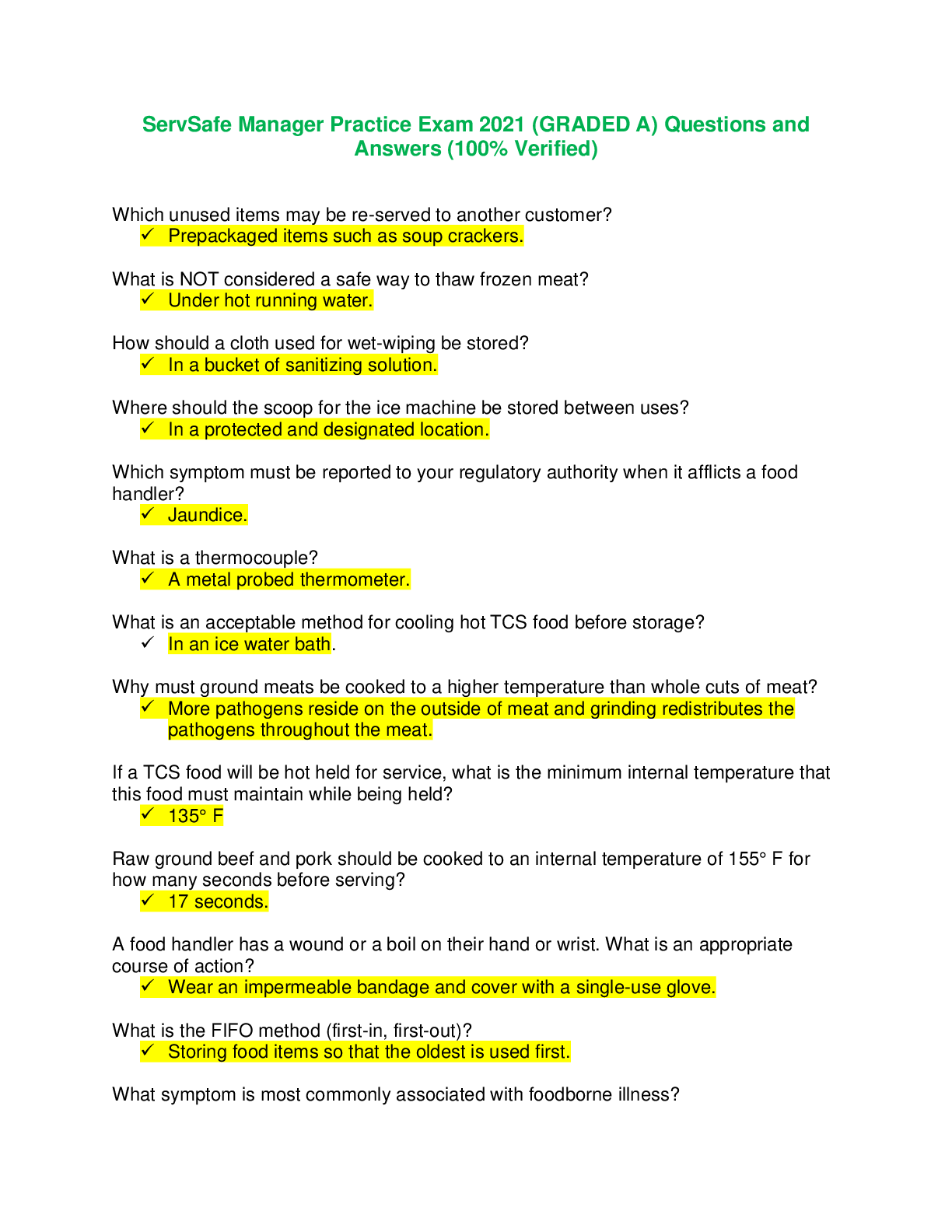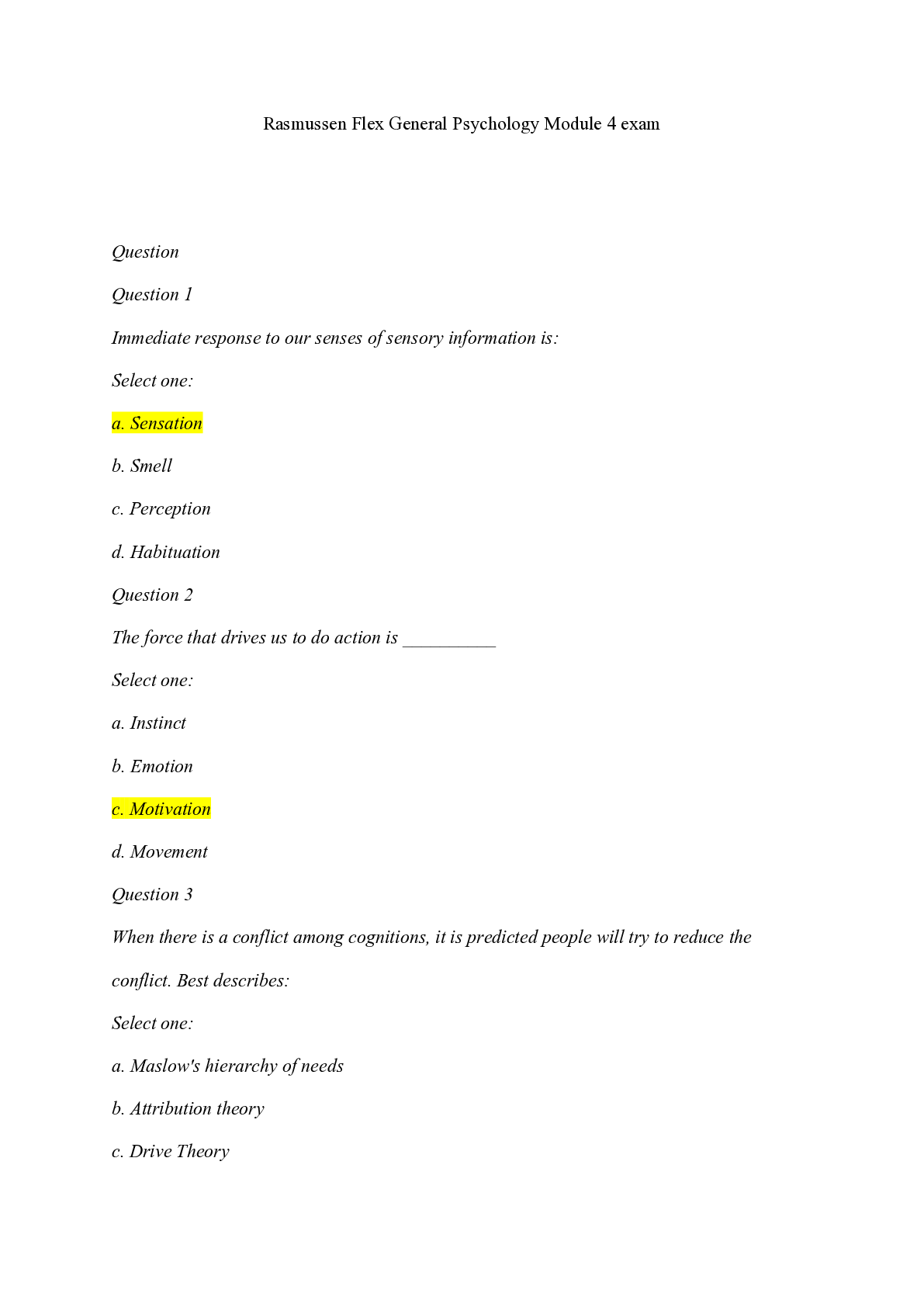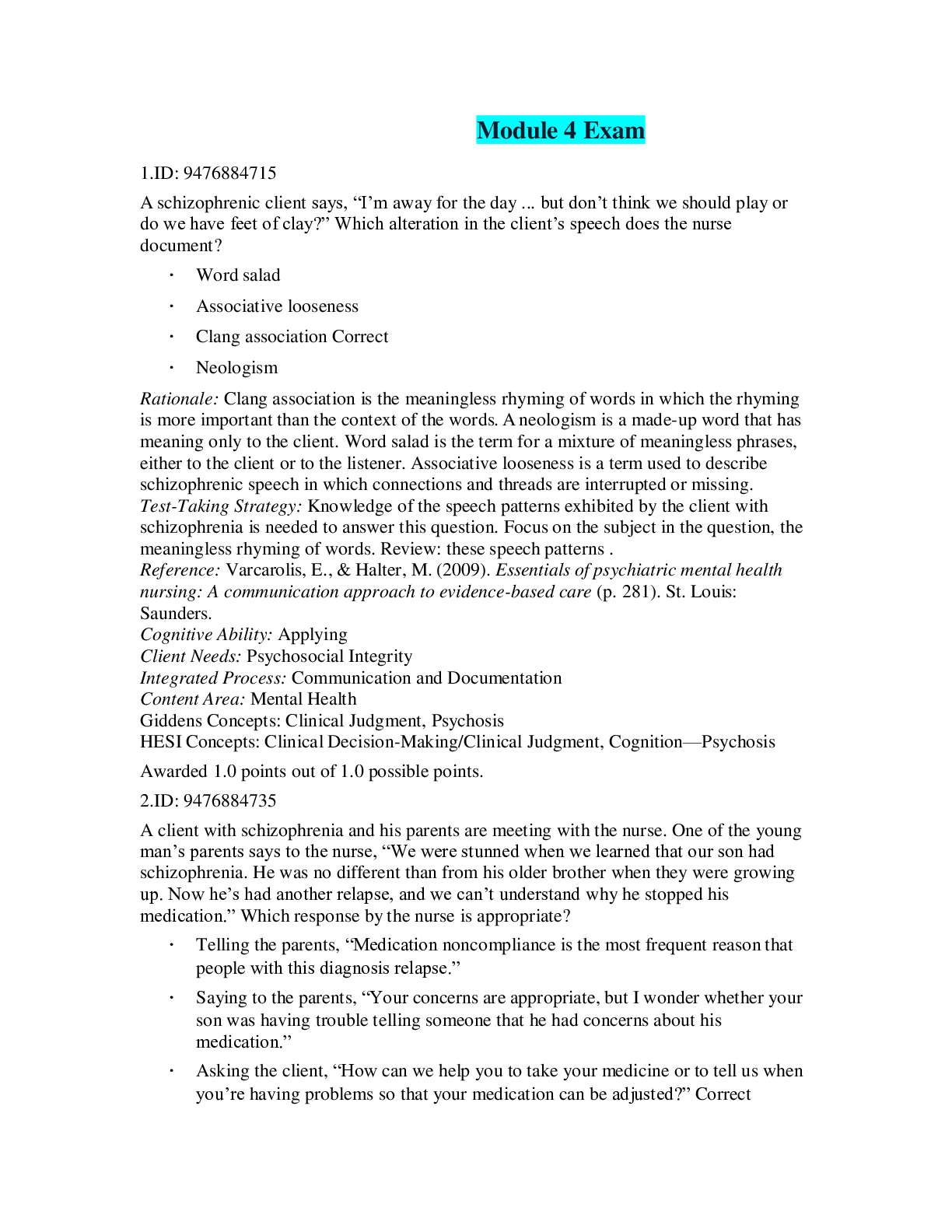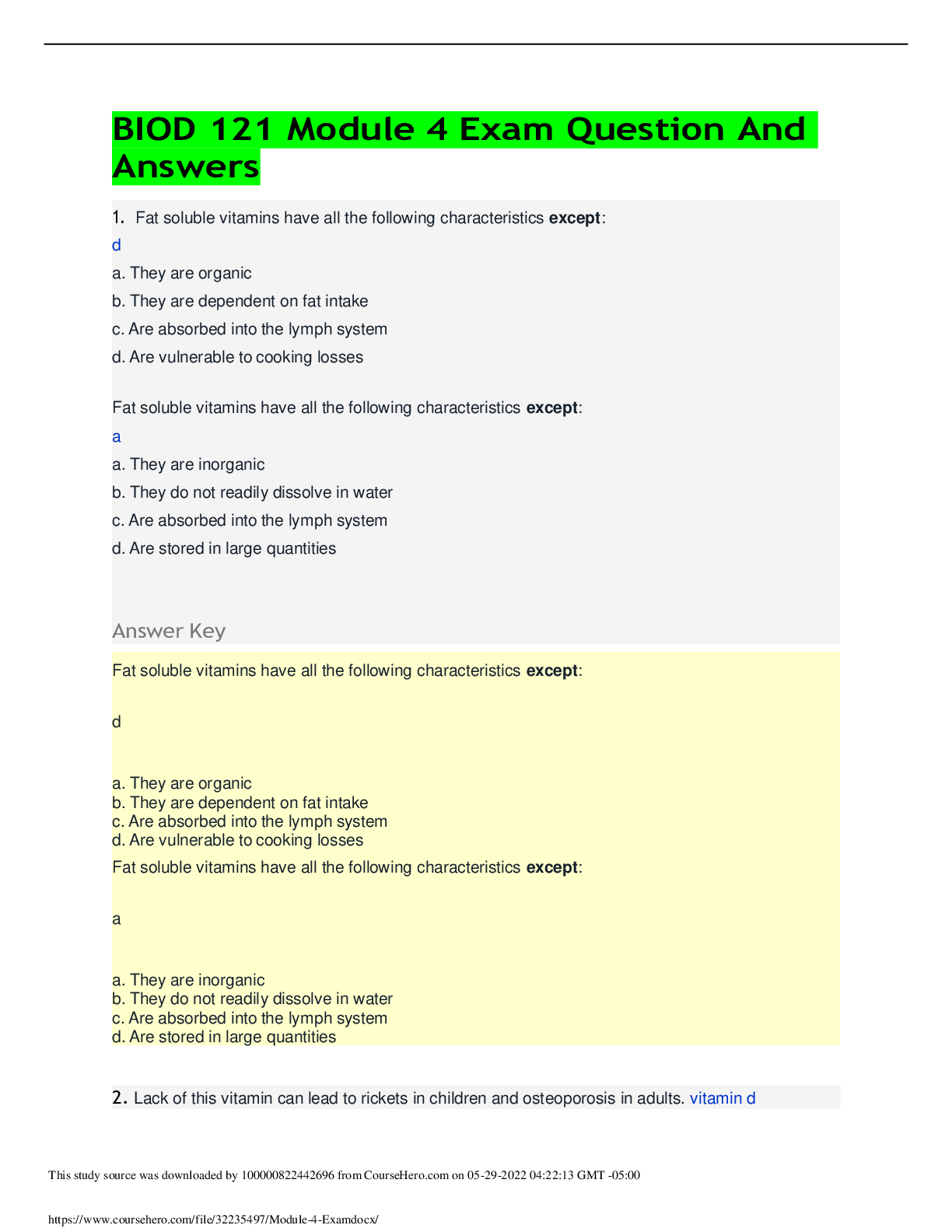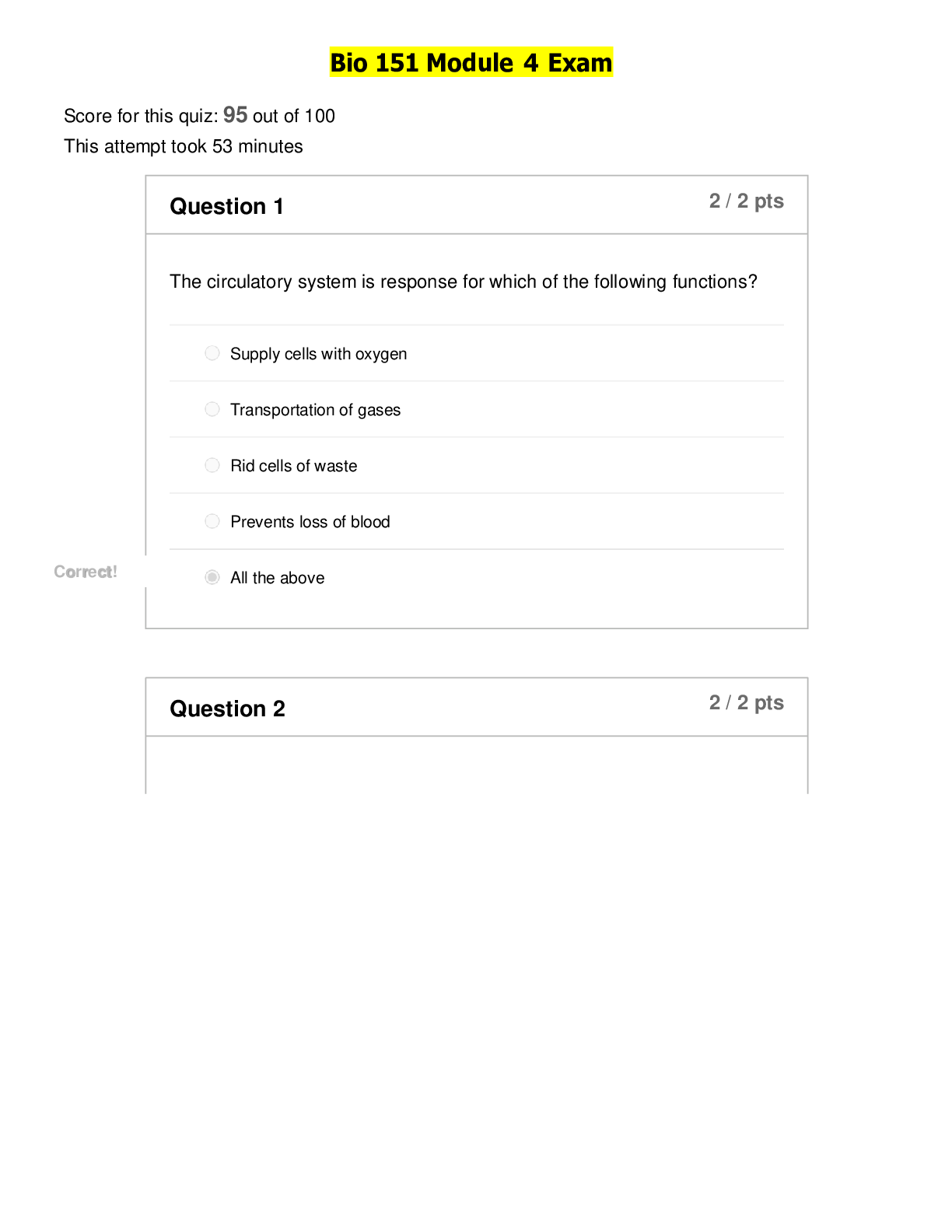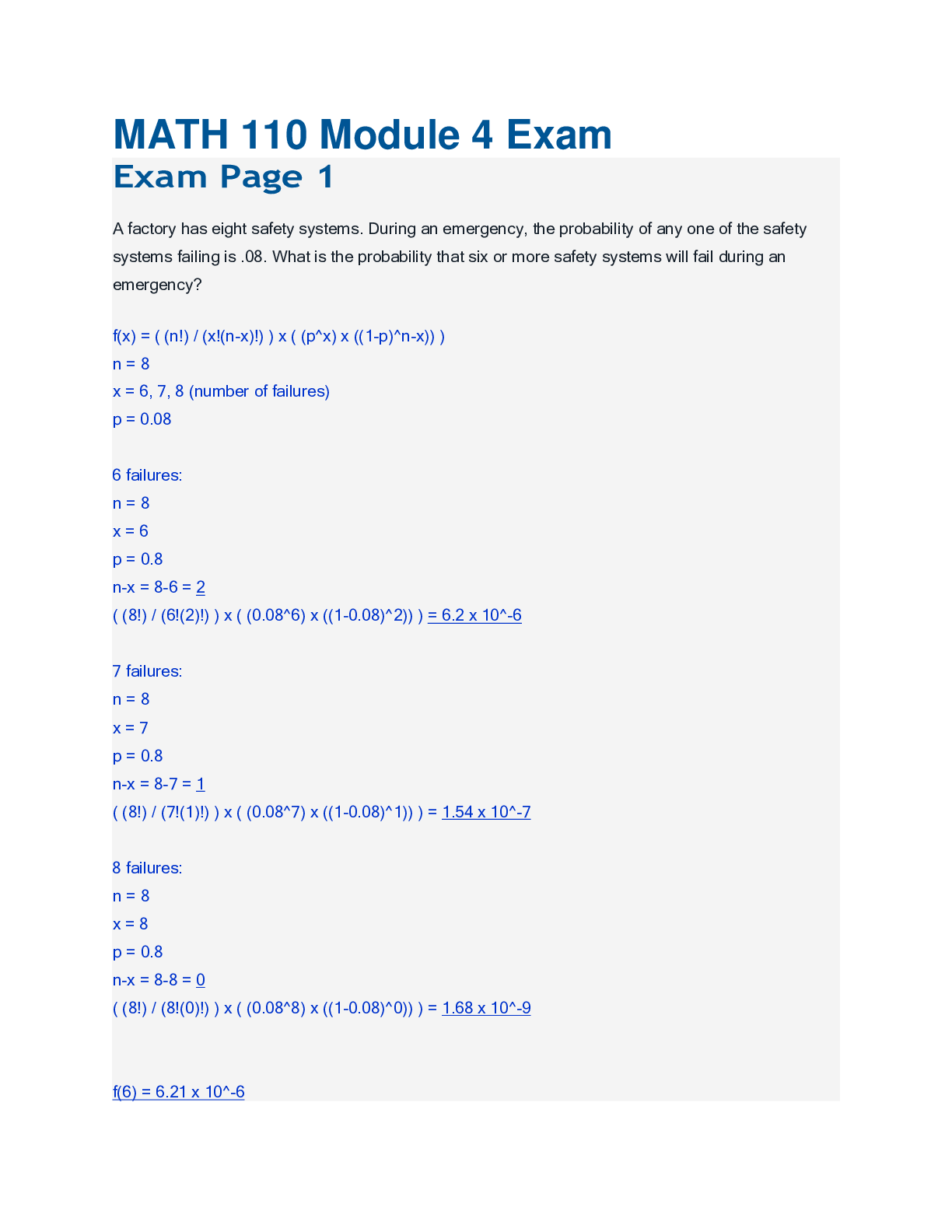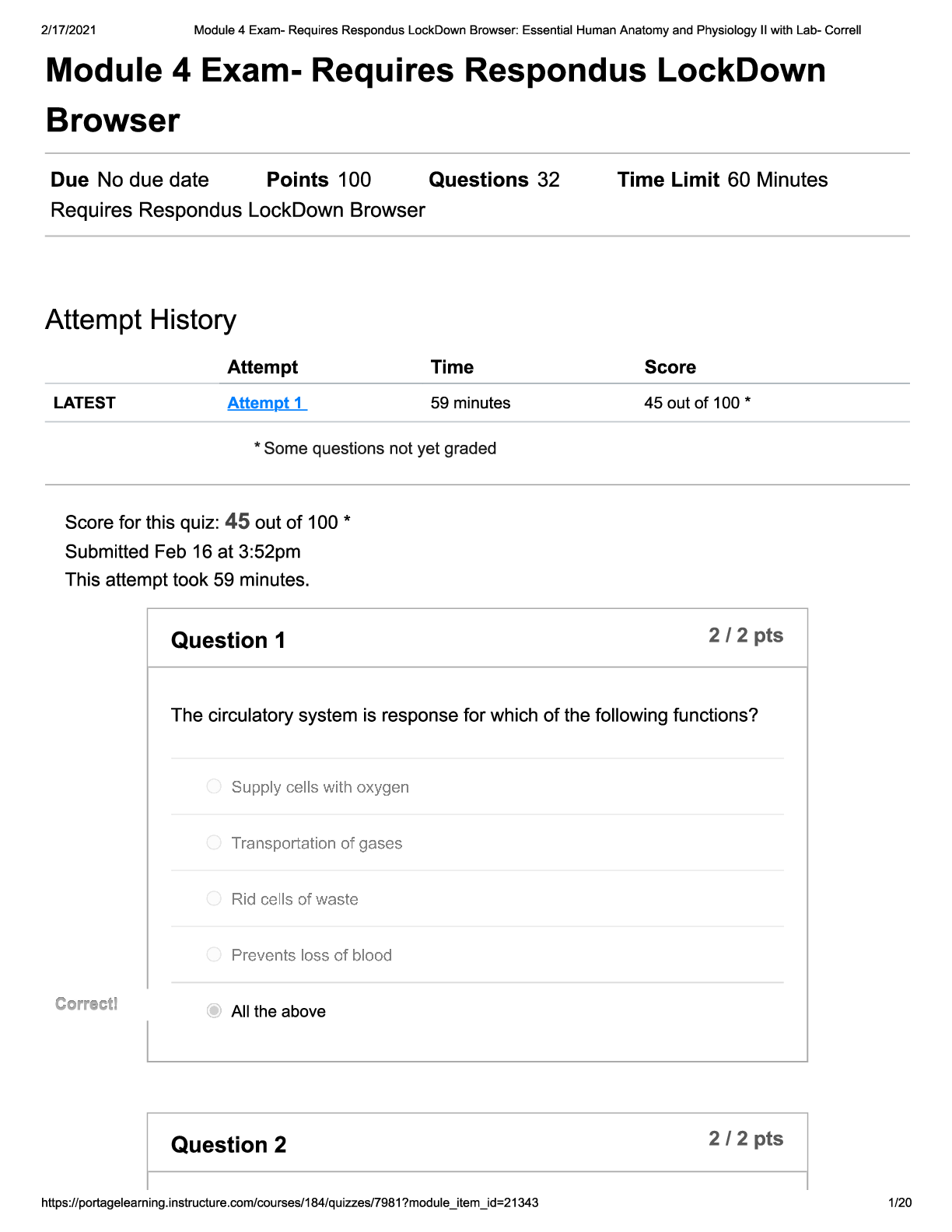Biology > EXAM > BIO 171 Module 4 Exam (GRADED A- Questions & Answers)- Microbiology- Portage Learning (All)
BIO 171 Module 4 Exam (GRADED A- Questions & Answers)- Microbiology- Portage Learning
Document Content and Description Below
BIO 171 Module 4 Exam True or False: Growth media is best suited for distinguishing between two similar species of bacteria. True False Growth media is designed to simply suppo... rt (and not restrict) microbial growth. A researcher is asked to determine which of two vials contains E coli and which contains salmonella. Knowing both are Gram-negative while only one of them is capable of fermenting lactose, which type of media would be best suited? Selective and Differential media Differential media Differential media distinguishes between two, often related, microbes. Growth media Selective media What are the requirements of a fastidious microbe? Your Answer: Fastidious microbe is an organism with complex requirements requirements ike absent it won't grow, enriched media contain those essential and specific nutrients required for growth of the particula subset of microorganisms A fastidious microbe is an organism with complex growth requirements such that if absent it will not grow. Enriched medias thus contain these specific and essential nutrients required for the growth of a particular subset of microorganisms. True or False: LB agar is classified as a non-selective, non-differential media. True LB agar is the most basic type of agar and like LB media supports the growth of virtually all microbes without restriction. False The polysaccharide-based hardening agent added to LB media to produce LB agar is derived from what? Your Answer: Seaweed extract Seaweed (algae) extract. Blood agar is which type of medium? Enriched Selective Selective and Differential Differential Blood agar can be used to differential between species based on its hemolytic activity. Match the following hemolytic class with its description of activity. 1. Alpha hemolysis A. No change. 2. Beta hemolysis B. Greenish-brown color 3. Gamma hemolysis C. Distinct zone of clearing 1 2 3 Columbia CNA agar is most closely related to which media: EMB agar MacConkey Agar Trypticase Soy Agar Blood agar CNA agar is similar to BAP as it is also enriched with blood and allows for differentiation based on hemolytic patterns. True or False: Chocolate agar gets its brown color from cocoa to produce an enriched media. True False Chocolate (cocoa) is never added to the media. The name is derived simply based on the color that actually comes from the presence of ‘cooked’ (lysed) red blood cells in the media. A researcher is studying a strain of E. coli currently growing on a MacConkey plate. However, the researcher can’t remember if E. coli is Gram-positive or Gram- negative. Would a Gram stain be necessary to confirm? Why or why not? Your Answer: No, A Gram stain will not be needed only Gram-negative microbes that grows on MacConkey agar, then E.Coli is Gram-negative microbe No. A Gram stain would not be necessary, as only Gram-Negative microbes will grow on MacConkey agar. Thus, E. coli is a Gram-Negative microbe. In an attempt to detect the presence of the pathogenic strain of E. coli O157:H7, a researcher spread a culture onto a MacConkey agar with failed results. What type of agar should they (correctly) try next? Why? Your Answer: Microbe should be plated on Sorbitol-MacConkey agar which is formulated for O157:H7. Pathogenic E.coli can ferment both sorbitol and lactose that is why colonies that ferment can be separated from colonies that are not able to ferment The microbe should be plated on SMAC (Sorbitol-MacConkey agar) as it is specifically formulated to detect O157:H7. Pathogenic E. coli (O157:H7) cannot ferment sorbitol while non-pathogenic E. coli can ferment both soribitol and lactose. Therefore, colonies that ferment (acidic conditions; non-pathogenic) can be differentiated from non-fermenters (neutral to basic conditions; pathogenic). In Eosin Methylene Blue (EMB) agar, what color indicates the presence of E. coli? Your Answer: Metallic Green Metallic Green Which type of agar media is best suited to support the growth of Staphylococcus? MacConkey agar Mannitol salt agar Chocolate agar. Columbia CNA agar Blood agar What is the process of spreading a bacterial culture onto a petri dish? Your Answer: Plating Plating Describe the primary advantage of using a petri dish over growing a liquid culture? Your Answer: Primary advantage is cells are held into place , bacterial cells multiply when they are grown in nutrient broth and are also free to move about but when the growth on agar within a petri dish it is fixed inorder to form colonies The primary advantage is that cells are held into place. When grown in a nutrient broth, bacterial cells can multiply but are free to move around in solution. When grown on agar within a petri dish the fixed in such as way as to form colonies. True or False: The visualization of colonies on a petri dish represents bacterial cells that have multiplied ~2-3 times. True False When an individual colony is visible on agar the bacterial cell has multiplied often a million times over. True or False. The purpose of a quadrant streak is to produce individual colonies of a bacterial population. Correct Answer True False To be considered a pure culture, the sample (1) can be traced back to a single cell and (2) ? Your Answer: The culture has to be free of external contaminants by placing pure sample which will not contain multiple bacterial species The culture must also be free from external contaminants. Simply put, a pure sample would never contain multiple bacterial species (ie) Strep and Staph. When performing a quadrant streak, the sample is spread across the plate in such as way as to form what? Your Answer: Dilution gradient is formed, resulting gradient always contain growth of individual colonies A dilution gradient is formed. The resulting gradient should always contain within it the growth of individual colonies. In what phase of a dilution streak would you expect to find the lowest concentration of bacteria, P2 or P4? Your Answer: Phase 4 contains the lowest concentration of bacteris In this order of concentration P1>P2>P3>P4 P4 (Phase 4) would contain the lowest concentration of bacteria. The phases rank (from highest to lowest), P1 > P2 > P3 > P4. True or False. When performing a dilution streak a new (or sterilized) loop is not required for each phase as long as the bacterial culture is pure. True False A new or sterilized loop is absolutely required for each phase. Failure to do so would prevent the establishment of a dilution gradient, as the same bacterial concentration would be spread across both phase regions, regardless of whether or not the culture is pure. In order to encourage growth of a slow growing microbe what might a researcher do during a phase dilution streak? Your Answer: The researcher might decide to only perform only a 3 phase dilution streak of pass the loop through the previous phase multiple times. A researcher may either (1) opt to perform only a 3-phase dilution streak or (2) pass the loop through the previous phase multiple times (as opposed to only once). True or False. Pathogenic strains of bacteria tend to grow slower than normal non- pathogenic bacterial strains. True False Pathogenic strains of bacteria tend to grow faster than non-pathogenic strains at 37°C, which is why researchers may set incubators at 25°C to restrict its growth. When given an unknown bacterial sample the first step is to expand the current bacterial population. Which form of media best suites this need? Why? 1. MSA agar 2. LB media containing ampicillin and neomycin 3. MacConkey agar 4. Blood agar Your Answer: B. LB Media The rest of the forms listed are of selective media which means they might potentially prevent growth in the unknown sample. The culture is best to be expanded first. Blood agar. All other options (A, B and C) are all forms of selective media, meaning they may potentially inhibit the growth of the unknown sample. Although blood agar is considered a differential media, it is, most importantly, a non-selective media. Given the alternatives, this is the best option. [Show More]
Last updated: 2 years ago
Preview 1 out of 9 pages
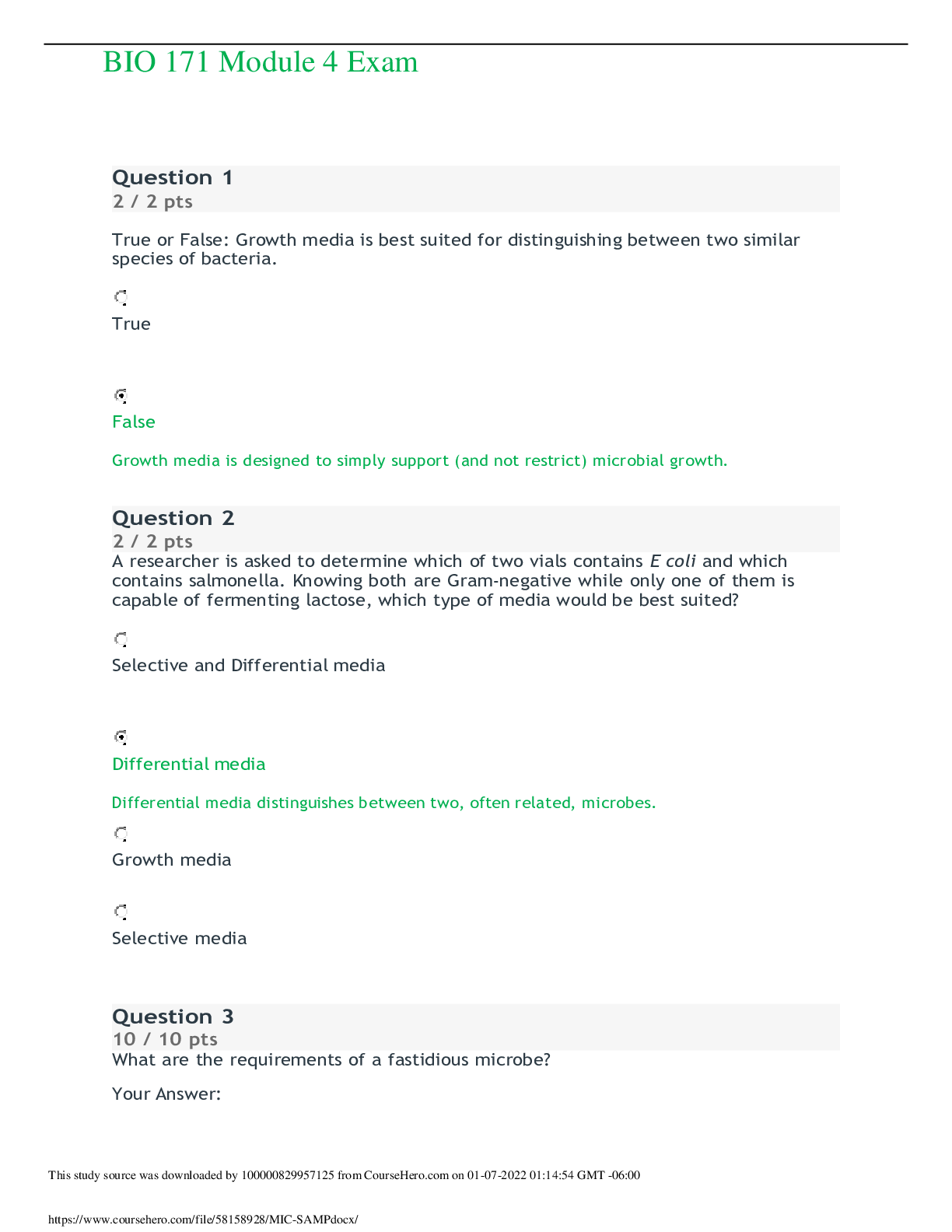
Buy this document to get the full access instantly
Instant Download Access after purchase
Buy NowInstant download
We Accept:

Reviews( 0 )
$10.00
Can't find what you want? Try our AI powered Search
Document information
Connected school, study & course
About the document
Uploaded On
Jan 07, 2022
Number of pages
9
Written in
Additional information
This document has been written for:
Uploaded
Jan 07, 2022
Downloads
0
Views
105

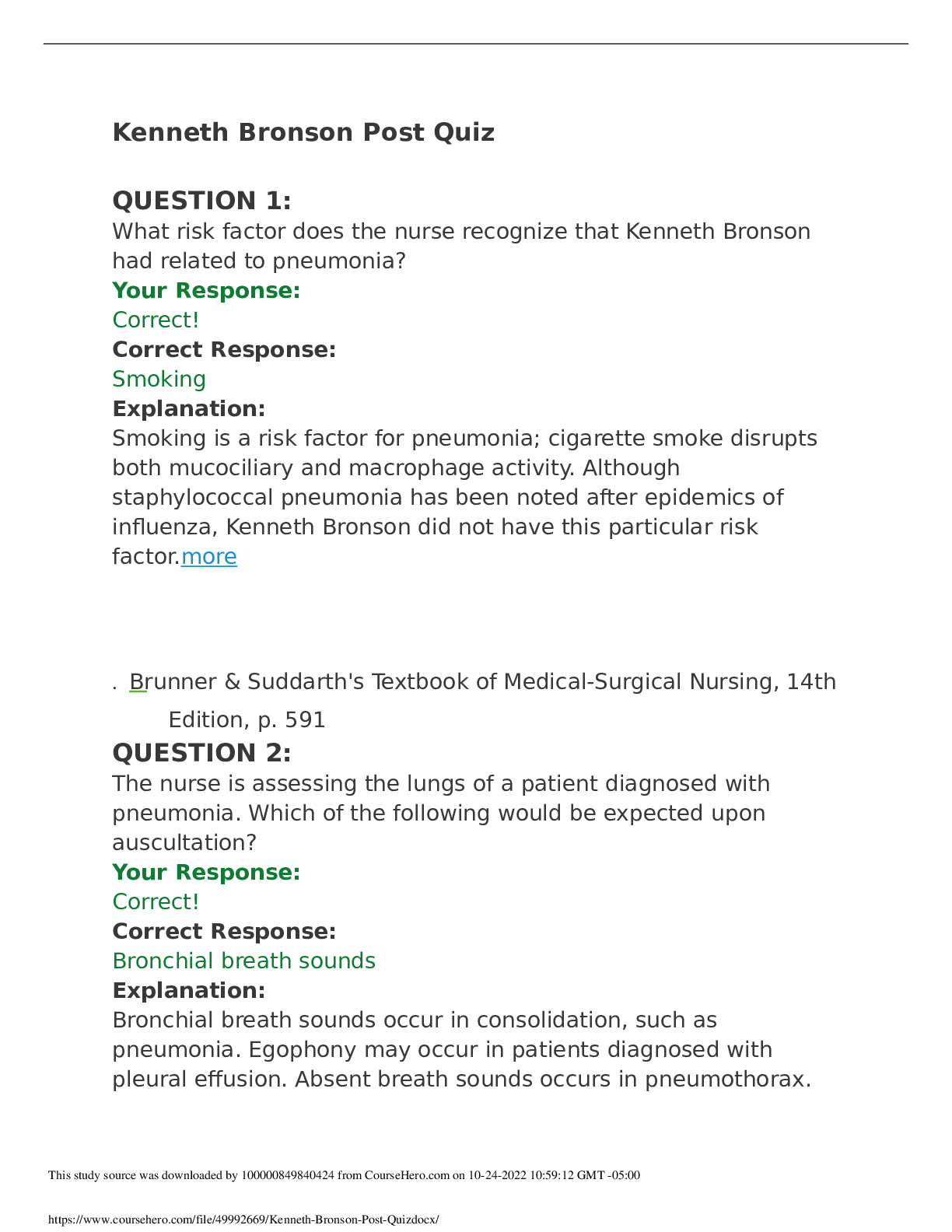



 Questions and Answers 100% VERIFIED.png)
 Questions and Answers 100% correct Solutions.png)



